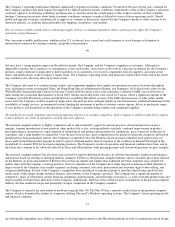Apple 2003 Annual Report Download - page 42
Download and view the complete annual report
Please find page 42 of the 2003 Apple annual report below. You can navigate through the pages in the report by either clicking on the pages listed below, or by using the keyword search tool below to find specific information within the annual report.
difficulties in incorporating the acquired companies' operations and technologies; distraction of management's attention away from normal
business operations; insufficient revenue generation to offset liabilities assumed and expenses associated with acquisition; and unidentified
issues not discovered in the Company's due diligence process, including product quality issues and legal contingencies. Acquisitions are
inherently risky, and no assurance can be given that the Company's previous or future acquisitions will be successful and will not materially
adversely affect business, operating results or financial condition. The Company has generally paid cash for its acquisitions. Should the
Company issue its common stock or other equity related purchase rights as consideration in an acquisition, current shareholders' percentage
ownership and earnings per share may become diluted.
51
Item 7A. Quantitative and Qualitative Disclosures About Market Risk
Interest Rate and Foreign Currency Risk Management
To ensure the adequacy and effectiveness of the Company's foreign exchange and interest rate hedge positions, as well as to monitor the risks
and opportunities of the non-hedge portfolios, the Company regularly reviews its foreign exchange forward and option positions, and its
interest rate swap and option positions both on a stand-alone basis and in conjunction with its underlying foreign currency and interest rate
related exposures, respectively, from both an accounting and an economic perspective. However, given the effective horizons of the Company's
risk management activities and the anticipatory nature of the exposures intended to hedge, there can be no assurance the aforementioned
programs will offset more than a portion of the adverse financial impact resulting from unfavorable movements in either foreign exchange or
interest rates. In addition, the timing of the accounting for recognition of gains and losses related to mark-to-market instruments for any given
period may not coincide with the timing of gains and losses related to the underlying economic exposures and, therefore, may adversely affect
the Company's operating results and financial position. The Company adopted SFAS No. 133 as of October 1, 2000. SFAS No. 133 established
accounting and reporting standards for derivative instruments, hedging activities, and exposure definition. Management does not believe that
ongoing application of SFAS No. 133 will significantly alter the Company's hedging strategies. However, its application may increase the
volatility of other income and expense and other comprehensive income.
Interest Rate Risk
While the Company is exposed to interest rate fluctuations in many of the world's leading industrialized countries, the Company's interest
income and expense is most sensitive to fluctuations in the general level of U.S. interest rates. In this regard, changes in U.S. interest rates
affect the interest earned on the Company's cash, cash equivalents, and short-
term investments as well as costs associated with foreign currency
hedges.
The Company's fixed income investment policy and strategy is to ensure the preservation of capital, meet liquidity requirements, and optimize
return in light of the current credit and interest rate environment. The Company benchmarks its performance by utilizing external money
managers to manage a small portion of the aggregate investment portfolio. The external managers adhere to the Company's investment policies
and also provide occasional research and market information that supplements internal research used to make credit decisions in the investment
process.
During 1994, the Company issued $300 million aggregate principal amount of 6.5% unsecured notes in a public offering registered with the
SEC. The notes were sold at 99.925% of par, for an effective yield to maturity of 6.51%. The notes pay interest semiannually and mature on
February 15, 2004.
The Company's exposure to market risk for changes in interest rates relates primarily to the Company's investment portfolio and debt
obligations and related derivative financial instruments. The Company places its short-term investments in highly liquid securities issued by
high credit quality issuers and, by policy, limits the amount of credit exposure to any one issuer. The Company's general policy is to limit the
risk of principal loss and ensure the safety of invested funds by limiting market and credit risk. All highly liquid investments with maturities of
three months or less are classified as cash equivalents; highly liquid investments with maturities greater than three months are classified as
short-term investments. As of September 27, 2003, approximately $629 million of the Company's short-term investments had underlying
maturities ranging from 1 and 5 years. As of September 28, 2002, $1.087 billion of the Company's investment portfolio classified as short-term
investments had maturities ranging from 1 to 5 years. The remainder all had underlying maturities between 3 and 12 months. Due to liquidity
needs, or in anticipation of credit deterioration, or for the purpose of duration management of the Company's investment portfolio, the
Company may sell investments prior to their stated maturities. As a result of such activity, the Company recognized net gains of $21 million in
2003 and $7 million in 2002.
52
In order to provide a meaningful assessment of the interest rate risk associated with the Company's investment portfolio, the Company
























